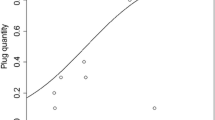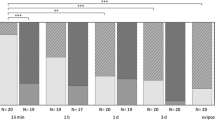Abstract
In order to avoid sperm competition, males of many taxa apply physical barriers, so-called mating plugs, into female genitalia. Females may control which males deposit a plug through pre-copulatory mate choice or by influencing plug efficacy to avoid costs imposed by plugging. However, subsequent suitors might remove the plugs. We investigated behavioural and morphological aspects of plug deposition and removal in a promiscuous spider, Philodromus cespitum (Philodromidae). We performed mating trials to investigate factors affecting plugging. To identify the plug origin, we conducted a morphological analysis using 3D X-ray microtomography and histology of the male copulatory organ and the female genital tract. In P. cespitum, the plug material is produced in the male genital bulb and transferred to the female together with sperm. The copulation is brief and terminated by the female. After mating, plugging material was found in the genital atrium of all females, covering it to a varying degree (10–100%). The extent of coverage was associated with the duration of movements of male copulatory organ connected with sperm transfer (i.e. full haematodochal expansions) and with the number of taps a male delivered with his legs to the female during courtship. Males larger than the female performed more tapping movements. Mating trials with plugged females revealed that males could remove plugs partly or entirely. Removal success increased with increasing foreleg length ratio between the male who removed the plug and the one who deposited it. We discuss our results in the light of the potential female control of plug deposition and removal.







Similar content being viewed by others
References
Aisenberg A, Eberhard WG (2009) Female cooperation in plug formation in a spider: effects of male copulatory courtship. Behav Ecol 20:1236–1241
Arnqvist G, Rowe L (2005) Sexual conflict. Princeton University Press, Princeton
Austad SN (1984) Evolution of sperm priority patterns in spiders. In: Smith RL (ed) Sperm competition and the evolution of animal mating systems. Academic Press, New York, pp 223–249
Baer B, Morgan ED, Schmid-Hempel P (2001) A nonspecific fatty acid within the bumblebee mating plug prevents females from remating. Proc Natl Acad Sci U S A 98:3926–3928
Barker DM (1994) Copulatory plugs and paternity assurance in the nematode Caenorhabditis elegans. Animal Behav 48:147–156
Berendonck B, Greven H (2002) Morphology of female and male genitalia of Latrodectus revivensis Shulov, 1948 (Araneae, Theridiidae) with regard to sperm priority patterns. In: Toft S, Scharff N (eds) European arachnology 2000. Aarhus University Press, Aarhus, pp 157–167
Braun R (1956) Zur Biologie von Teutana triangulosa (Walck.) (Araneae; Theridiidae, Asageneae). Z wiss Zool Abt A 159:255–318
Dixson AL, Anderson MJ (2002) Sexual selection, seminal coagulation and copulatory plug formation in primates. Folia Primatol 73:63–69
Eberhard WG (1996) Female control: sexual selection by cryptic female choice. Princeton University Press, Princeton
Eberhard WG, Huber BA (1998) Courtship, copulation, and sperm transfer in Leucauge mariana (Araneae, Tetragnathidae) with implications for higher classification. J Arachnol 26:342–368
Elgar MA (1998) Sperm competition and sexual selection in spiders and other arachnids. In: Birkhead TR, Møller AP (eds) Sperm competition and sexual selection. Academic Press, London, pp 307–339
Foelix RF (2011) Biology of spiders, 3nd edn. Oxford University Press, Oxford
Foellmer MW (2008) Broken genitals function as mating plugs and affect sex ratios in the orb-web spider Argiope aurantia. Evol Ecol Res 10:449–462
Fromhage L (2012) Mating unplugged: a model for the evolution of mating plug (dis-) placement. Evolution 66:31–39
Fromhage L, Schneider JM (2005) Virgin doves and mated hawks: contest behaviour in a spider. Anim Behav 70:1099–1104
Fromhage L, Schneider JM (2006) Emasculation to plug up females: the significance of pedipalp damage in Nephila fenestrata. Behav Ecol 17:353–357
Garcilazo-Cruz U, Alvarez-Padilla F (2015) Description of a novel mating plug mechanism in spiders and the description of the new species Maeota setastrobilaris (Araneae, Salticidae). ZooKeys 509:1–12
Gutiérrez F, Cordero C (2015) Incidence and permanence of mating plugs in females of the spider Philoponella tingens (Uloboridae). J Ethol 33:59–63
Herberstein ME, Wignall AE, Nessler SH, Harmer AMT, Schneider JM (2012) How effective and persistent are fragments of male genitalia as mating plugs? Behav Ecol 23:1140–1145
Jackson RR (1980) The mating strategy of Phidippus johnsoni (Araneae, Salticidae): II. Sperm competition and the function of copulation. J Arachnol 8:217–240
Jennions MD, Petrie M (2000) Why do females mate multiply? A review of the genetic benefits. Biol Rev Camb Philos Soc 75:21–64
Jones TM (2001) A potential cost of monandry in the lekking sandfly Lutzomyia longipalpis. J Insect Behav 14:385–399
Karnovsky MJ (1965) A formaldehyde glutaraldehyde fixative of high osmolality for use in electron microscopy. J Cell Biol 27:137
Knoflach B (1998) Mating in Theridion varians Hahn and related species (Araneae: Theridiidae). J Nat Hist 32:545–604
Knoflach B (2004) Diversity in the copulatory behaviour of comb-footed spiders (Araneae, Theridiidae). Denisia 12:161–256
Kokko H, Mappes J (2013) Multiple mating by females is a natural outcome of a null model of mate encounters. Entomol Exp App 146:26–37
Kotiaho J, Alatalo RV, Mappes J, Parri S (1996) Sexual selection in a wolf spider: male drumming activity, body size, and viability. Evolution 50:1977–1981
Kuntner M, Agnarsson I, Li D (2015) The eunuch phenomenon: adaptive evolution of genital emasculation in sexually dimorphic spiders. Biol Rev 90:279–296
Kuntner M, Coddington JA, Schneider JM (2009) Intersexual arms race? Genital coevolution in nephilid spiders (Araneae, Nephilidae). Evolution 63:1451–1463
Kuntner M, Gregorič M, Zhang S, Kralj-Fišer S, Li D (2012) Mating plugs in polyandrous giants: which sex produces them, when, how and why? PLoS One 7:e40939
Kunz K, Witthuhn M, Uhl G (2014) Do the size and age of mating plugs alter their efficacy in protecting paternity? Behav Ecol Sociobiol 68:1321–1328
Masumoto T (1993) The effect of the copulatory plug in the funnel-web spider, Agelena limbata (Araneae: Agelenidae). J Arachnol 21:55–59
Moore AJ, Gowaty PA, Moore PJ (2003) Females avoid manipulative males and live longer. J Evol Biol 16:523–530
Parker GA (1970) Sperm competition and its evolutionary consequences in the insects. Biol Rev 45:525–567
Parker GA (1984) Sperm competition and the evolution of animal mating systems. In: Smith RL (ed) Sperm competition and the evolution of animal mating systems. Academic Press, New York, pp 1–60
Pekár S, Brabec M (2016) Modern analysis of biological data. Generalized linear models in R. Masaryk University, Brno
Pitcher TE, Neff BD, Rodd FH, Rowe L (2003) Multiple mating and sequential mate choice in guppies: females trade up. Proc R Soc Lond B Biol Sci 270:1623–1629
Prenter J, MacNeil C, Elwood RW (2006) Sexual cannibalism and mate choice. Anim Behav 71:481–490
Ramirez MG, Achekian AC, Coverley CR, Pierce RM, Eiman SS, Wetkowski MM (2010) Male remating success and the frequency of copulatory plugs in the green lynx spider Peucetia viridans (Araneae, Oxyopidae). Psyche J Entom 2010:1–10
R Development Core Team (2010) R: A language and environment for statistical computing. Vienna: R Foundation for Statistical Computing, online at http://www.R-project.org. Accessed 12 Jan 2012.
Richardson KC, Jarett L, Finke EH (1960) Embedding in epoxy resins for ultrathin sectioning in electron microscopy. Stain Technol 35:313–323
Robinson MH, Robinson B (1980) Comparative studies of the courtship and mating behavior of tropical araneid spiders. Pac Ins Monogr 36:1–218
Schneider JM, Thomas ML, Elgar MA (2001) Ectomised conductors in the golden orb-web spider, Nephila plumipes (Araneoidea): a male adaptation to sexual conflict? Behav Ecol Sociobiol 49:410–415
Sentenská L, Pekár S, Lipke E, Michalik P, Uhl G (2015) Female control of mate plugging in a female-cannibalistic spider (Micaria sociabilis). BMC Evol Biol 15:18
Shine R, Olsson MM, Mason RT (2000) Chastity belts in gartersnakes: the functional significance of mating plugs. Biol J Linn Soc 70:377–390
Simmons LW (2001) Sperm competition and its evolutionary consequences in the insects. Princeton University Press, Princeton
Singer F, Riechert SE (1995) Mating system and mating success of the desert spider Agelenopsis aperta. Behav Ecol Sociobiol 36:313–322
Snow LS, Abdel-Mesih A, Andrade MCB (2006) Broken copulatory organs are low-cost adaptations to sperm competition in redback spiders. Ethology 112:379–389
Suhm M, Thaler K, Alberti G (1996) Glands in the male palpal organ and the origin of the mating plug in Amaurobius species (Araneae: Amaurobiidae). Zool Anz 234:191–199
Uhl G, Schmitt S, Schäfer MA (2005) Fitness benefits of multiple mating versus female mate choice in the cellar spider (Pholcus phalangioides). Behav Ecol Sociobiol 59:69–76
Uhl G, Busch M (2009) Securing paternity: mating plugs in the dwarf spider Oedothorax retusus (Araneae: Erigoninae). Biol J Linn Soc 96:574–583
Uhl G, Nessler SH, Schneider JM (2010) Securing paternity in spiders? A review on occurrence and effects of mating plugs and male genital mutilation. Genetica 138:75–104
Uhl G, Kunz K, Vöcking O, Lipke E (2014) A spider mating plug: origin and constraints of production. Biol J Linn Soc 113:345–354
von Helversen O (1976) Gedanken zur Evolution der Paarungsstellung bei den Spinnen (Arachnida: Araneae). Entomol Ger 3:13–28
Watson PJ (1998) Multi-male mating and female choice increase offspring growth in the spider Neriene litigiosa (Linyphiidae). Anim Behav 55:387–403
Wigby S, Chapman T (2004) Sperm competition. Curr Biol 14:R100–R103
Yan J (2002) Geepack: yet another package for generalized estimating equations. R-News 2:12–14
Zeh JA, Zeh DW (2001) Reproductive mode and the genetic benefits of polyandry. Anim Behav 61:1051–1063
Acknowledgments
We would like to thank Radek Michalko for help with collecting spiders in the field. Helpful comments were given by Pierick Mouginot, Carsten H.G. Müller, Peter Michalik and Radek Michalko. We thank Matjaž Gregorič and two anonymous referees for revision of the manuscript and their helpful comments. LS was supported by grant no. MUNI/A/1484/2014 provided by Masaryk University. Due to the University of Greifswald funding program for exchange between partner universities, research visits of LS to Greifswald were made possible, which is gratefully acknowledged. The 3D X-ray microscope was funded by the German Science Foundation (INST 292/119-1 FUGG und INST 292/120-1 FUGG).
Author information
Authors and Affiliations
Corresponding authors
Ethics declarations
Competing interests
The authors declare that they have no competing interests.
Ethical approval
All applicable international, national and/or institutional guidelines for the care and use of animals were followed.
Additional information
Communicated by: Matjaž Gregorič
Rights and permissions
About this article
Cite this article
Sentenská, L., Pekár, S. & Uhl, G. Deposition, removal and production site of the amorphous mating plug in the spider Philodromus cespitum. Sci Nat 105, 50 (2018). https://doi.org/10.1007/s00114-018-1575-8
Received:
Revised:
Accepted:
Published:
DOI: https://doi.org/10.1007/s00114-018-1575-8




